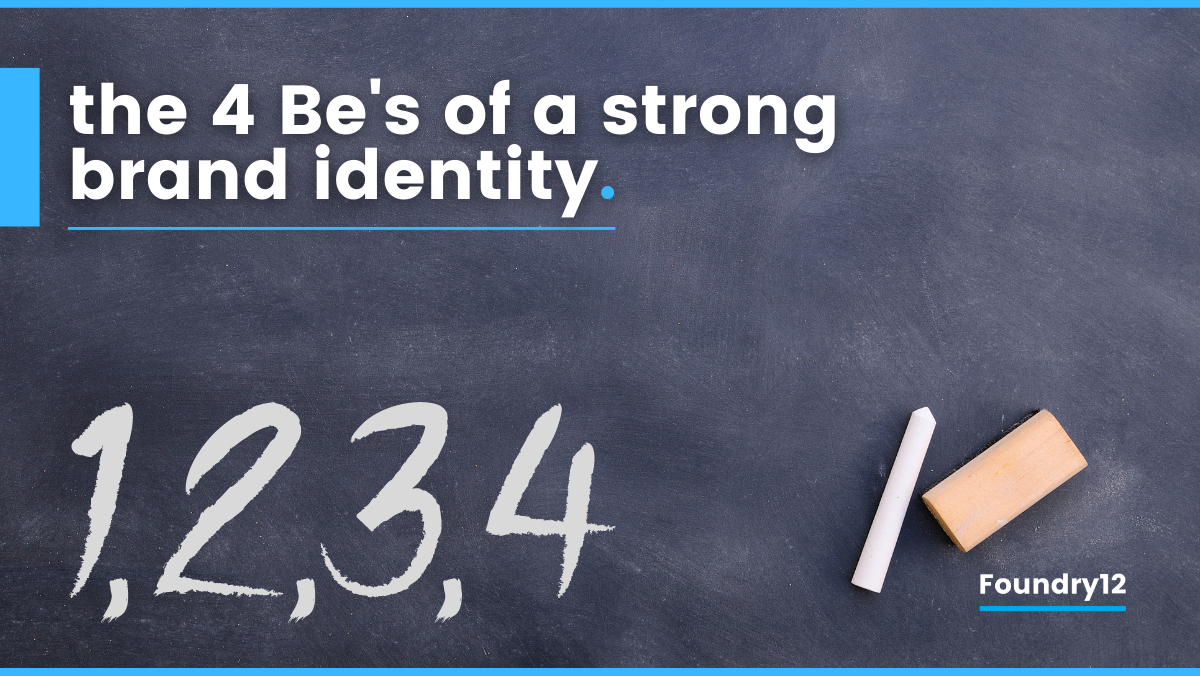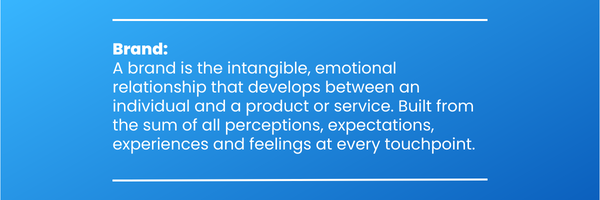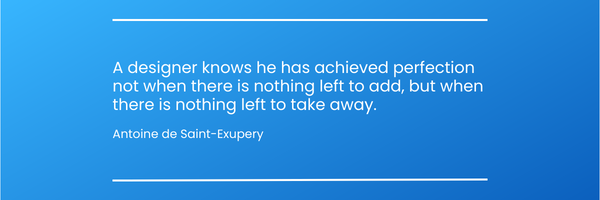All businesses want their brand to be the one people choose. The one their customers stay loyal to, and the one that continues to win new customers.
There are lots of things involved in that – the product or service itself, pricing, accessibility. But one thing’s for sure, your brand identity plays a huge part in making that happen. Or not happen.
And to make sure your brand sits firmly in the ‘make it happen’ camp, there are 4 Be’s crucial to creating a spot-on brand identity that delivers. Four things to ensure your brand identity helps you attract new customers and convert existing ones into loyal fans.
We’re going to cover those 4 Be’s in this article. But before you can start to successfully create your brand identity around them, you need to understand what your brand is. You need to define your vision, your mission, the values that guide you, the value proposition you offer. And who you’re targeting. If you don’t understand who and what you are, and what you’re trying to do, you can’t create an identity that reflects that and appeals to the right people.
So before getting stuck into the nuts and bolts of the 4 Be’s, let’s first define what a brand is.
What is a brand?
Whilst you can find an absolute smashillion pages on the tinterweb offering a wide range of different, slightly different and nuanced definitions for what a brand is, the description below is honed from over 25 years’ experience and insight working within brand marketing and advertising:
So whilst that’s a brand, remember those intangible and emotional relationships don’t necessarily have to be positive. We can all name brands we’ve had bad experiences with.
A successful brand is one that forms a strong, positive association in the minds of its customers that builds trust. By delivering experiences at every touchpoint that consistently meet or exceed expectations, it can influence thinking, create preference and form a lasting bond with customers. One that leads to successful long-term growth.
You can’t put the identity before the brand
If you haven’t defined your brand platform, you shouldn’t create a brand identity. Without a clear understanding of your vision, mission, values and value proposition you’ll most likely create something without foundations. There’s nothing to inform your decision making. Nothing that allows you to say ‘yep, based on who we are, if we looked like something, and sounded like something, that’s what it’d be’.
Worst of all, your customers and target audience won’t buy into it. They’ll see it lacks any authenticity and provenance. You won’t resonate with them and form those positive relationships.
If you don’t have that platform in place, talk to us. It’s what we do so it’s something we can help you with. But this piece is about the 4 Be’s that create a strong, coherent and compelling brand identity, once you have your platform in place.
Let’s return to that shall we.
What is brand identity?
Your brand identity is your brand brought to life. It’s the visual and verbal embodiment of what you represent – the way your business looks and feels, how you sound and speak.
Through a combination of your logo, colours, typography, tone of voice, use of imagery or illustrations, and your messaging, it’s what your customers and target audience are presented with.
And it greatly influences the way people perceive you.
Utilising all those elements to create your identity involves the development of distinctive visual codes, or identifiers, and a tone for your business. Forming a personality that should be aligned with your vision, mission and values. And present across every touchpoint.
The result should be a strong brand identity that sets you apart from your competitors, aids recognition, resonates with people, and evokes emotions that influence behaviour, create preference and foster loyalty. All of which are key, especially in a competitive market.
Time for the 4 Be’s
So we’ve briefly talked brand. And we’ve set out the importance of a strong, coherent and compelling brand identity. Now let’s talk about the 4 ‘Be’s’ that’ll help you develop your brand identity into one that’s recognised, trusted and preferred by all those you want to matter to.
1: Be Distinctive
The overwhelming majority of businesses exist in highly competitive, mature or homogenous markets. Very few have the advantage of little or no competition. Consequently, whether you’re the market leader, no. 2, a challenger or a new entrant, you need to give people reasons to choose you over your competition. You need to cut through the competitor noise to set you apart and get you noticed.
This is where your brand identity is your competitive advantage. Whilst it may be tough to differentiate your product or service in most markets, you can differentiate how you deliver it.
Just think about it. If you play it safe and copy your competitors or follow the leading brand, all you’re doing is blending in. You’re just background noise and become wallpaper. You come across as unoriginal and generic, therefore appear to lack a point of difference, failing to convince people to choose you over your competitors.
Worse still, people could see your brand and think of your competitors. You could be doing their job for them!
To avoid this happening, look into your values and value proposition to identify your point of difference. Unearth what sets you apart, what it is you offer and the problems you solve that allow you to stand out. Then with the confidence of knowing what makes you different, be bold and brave in translating that through your personality.
Create a visual and tonal identity that’s memorable and stops people in their tracks. One that reflects your strengths and forces them to consider your brand. And tell a story that creates an emotional connection by using empathy to highlight a truth your target audience can identify with. In a style that you can own. So when people see your communications they know it can only be you.
2: Be consistent
To be recognised and to successfully communicate your value, you need to be consistent. Why? Because consistent delivery of your brand helps create mental shortcuts in the minds of your customers and targets. If you consistently appear the same, wherever you are, whatever channel you’re in, you make it easier for them to instantly recognise you.
One of the biggest mistakes to make is inconsistency. Inconsistency of design, inconsistency of tone, inconsistency of message. Using different colours and fonts, or being erratic with your language style across different channels, can confuse your audience. If you constantly fail to pay attention to the detail and don’t appear to know who or what you are, what does that say to everyone else? Inconsistent delivery across different messages or different platforms will dilute your brand identity and weaken your credibility. All making it harder for you to succeed.
Conversely, being consistent across all touchpoints reinforces your values and your message in the minds of your audience.
Just think of the brands you recognise by their consistent use of colour, font, tone of message, sound or style of communication. Brands that you recognise straight away because of the distinctive codes they use to coherently frame or house each message across all different channels. Brands that make it easy for people.
So be consistent. Determine the colours that represent your brand personality. The kind of font that best fits who you are. The illustrative or graphical assets or photographic style, and the tone of voice. And use them consistently in your communications so you’re always saying ‘this is us’.
(For more on the psychology of colour in branding, check this out)
3: Be focused
Don’t over complicate your brand identity. Clarity and simplicity of both design and message helps people quickly process who you are and what you’re saying to them. If you over complicate or clutter your design or your message, you force people to work harder at identifying who you are and what you’re trying to say. And the more difficult you make it for people, the less likely they are to engage with you.
Don’t use more words when less will do. Don’t use too many colours that clash with each other and become an unnecessary distraction. Avoid using too many fonts that require someone to constantly adjust and make processing of information more difficult. And don’t try to put too many messages into each communication. Having less messages in each piece of communication increases the chance of that message being received and understood. And don’t keep switching styles. You only making it more difficult for people to identify you.
So simplify and streamline your brand identity and your communications until you have the least amount of elements necessary to clearly tell people it’s you. Use clear and concise language that conveys your core message and value proposition. And use visual elements that support the message and reinforce your brand identity.
4: Be relevant
Continually communicating your relevance is important in maintaining loyal customers and attracting new ones. To avoid appearing or sounding outdated is an ongoing challenge requiring detailed understanding of your target audience and their motivations. They have to be convinced the value you offer solves their problems, meets their current needs, and will meet their future needs.
To avoid your brand identity and messaging becoming irrelevant or outdated, use language, visuals and messages that resonate with your audience because they directly address their needs, challenges or pain points. And support their values and motivations. Being able to do this successfully stems from your understanding of the target audience and market(s) you operate in
Being relevant also requires adaptability. Adapting or evolving your brand identity over time to changing market conditions, customer feedback or industry trends.
Failure to remain relevant will leave your brand exposed to your competition and the needs of the market. Ultimately you can look out of touch and disconnected. Or even obsolete.
To guard against this, make sure you carry out regular research and analysis of your audience, your competitors, and your industry. Be in constant contact with your customers and key stakeholders, taking on board and adapting to their feedback.
All of this should allow you to keep your brand identity fresh, engaging and at the forefront, maintaining your relevance.
Simple isn’t it?
As humans, we don’t like anything that makes things more difficult for us. We’re drawn to the things that are easier, the things that don’t involve too much complicated processing, the things we recognise, and the things that offer us what we’re looking. We engage with the things we can grasp easily, and the things that resonate with us.
By concentrating on these 4 Be’s to develop a strong, memorable, and recognisable brand identity, your business can stand out from your competition and resonate with your audience. Helping create powerful connections that drive your growth.
Remember that when you’re considering the development of your brand identity. And remember us. We can take you through the process step by step, giving you all the support you need to build the brand identity you want.
It just starts with a chat.
________________
Other related posts you might be interested in:





